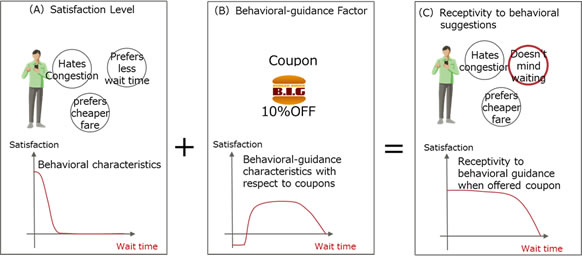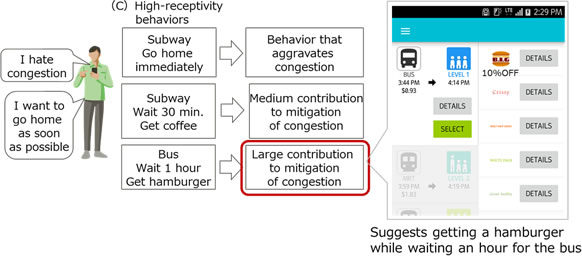Kawasaki, Japan, November 05, 2015
Fujitsu Laboratories Ltd. today announced that on November 1 in Singapore it commenced a field trial that aims to reduce congestion around major events, stadiums, and shopping centers.
This field trial uses a smartphone application that, based on the expected congestion when people return home from major events, proposes behavior or how to spend time best suited to the user, and then verifies the results. These suggestions for behavior are generated by Human Centric AI Zinrai, Fujitsu Limited's systematic approach to artificial-intelligence. This technology works to fine-tune the details of suggestions with the goal of mitigating congestion, by shifting times of peak traffic and modes of transportation.
Background
In the domain of social innovation, Fujitsu Laboratories has been conducting research to solve a wide range of public problems. Fujitsu, making use of Fujitsu Laboratories' R&D prowess, established in Singapore the Centre of Excellence(1), a cutting-edge research institute, together with Singapore's Agency for Science, Technology and Research, and the Singapore Management University in October 2014. The topics of research and development being worked on include relieving congestion in large cities and improving the routes pedestrians take.
Typically, congestion occurs when the movement of people is concentrated at a particular time or on a particular transit mode, in excess of capacity. To relieve congestion, national and local governments will build roads, add rail lines, and undertake other infrastructure expansion. But these efforts require costly, disruptive, large-scale construction projects. Fujitsu Laboratories, focused on human behavior, is testing whether it is possible to encourage people to modify their preferred departure time or mode of transit by offering discount fares or incentives to visit neighboring shops and restaurants.
Issues
If some people are amenable to modifying their departure times or mode of transit, it is important to avoid engendering resentment toward those who did not modify their behavior. Additionally, to date, it has not been clear what specific suggestions will induce people to happily modify their behavior, or what the metrics of those suggestions should be.
Summary of the Field Trial
| Purpose |
: |
Test the effectiveness of congestion mitigation through behavioral guidance |
| Trial period |
: |
Nov 1, 2015 through Dec 31, 2017 (scheduled) |
| Trial location |
: |
Event sites, stadiums, and shopping centers in Singapore |
| Target population |
: |
Several tens of thousands of people |
About the Technology
Fujitsu Laboratories developed a behavioral-guidance model that represents receptivity to behavioral suggestions as a formula (Figure 1).
This technology, founded on technology that balances the mobility needs of individuals with the profitability of businesses(2), utilizes the machine-learning and prediction/optimization capabilities of Zinrai, Fujitsu's AI technology.
Model Overview
The model calculates people's receptivity to behavior-modifying suggestions that include incentives, based on satisfaction levels and behavioral-guidance factors.
A. Satisfaction level
This represents static behavioral characteristics, such as impatience or calmness, which do not change dynamically. This is calculated based on the following three points:
1. The level of congestion that a person can tolerate when using transit
2. How much a person can delay (or advance) departure in order to avoid congestion
3. How much a person is willing to pay
Figure 1A plots the change in satisfaction level against the length of delay until departure: The curve indicates that satisfaction declines as the delay until departure increases. Satisfaction is represented as an equation, and the variables of the equation are estimated by conducting surveys.
B. Behavioral-guidance factors
This expresses how satisfaction changes upon receiving incentives such as transit discounts, coupons, etc. This is represented using an equation similar to the one for satisfaction in 1A. Because a person's level of satisfaction upon receiving an incentive is likely to vary according to their mood, the participant's actual behavior, such as whether the offered coupon was used or not, needs to be monitored following a suggestion. This actual behavior is provided as feedback that trains the model.
C. Receptivity to behavioral suggestions
This combines satisfaction and behavioral-guidance factors, and calculates how the satisfaction level changes in response to incentives being offered. Figure 1C shows how offering of a coupon can extend the tolerable wait time of a particular user.
 Figure 1: Behavioral-guidance model
Figure 1: Behavioral-guidance model
The behavioral-guidance model identifies several high-receptivity behaviors. Then, by extracting those behaviors which contribute the most to congestion mitigation, it discovers the behaviors that people are likely to be receptive to, and that are linked to mitigating congestion. By displaying the extracted behavior options on smartphones, the system suggests optimal behaviors (Figure 2).
 Figure 2: Suggesting behaviors linked to relieving congestion
Figure 2: Suggesting behaviors linked to relieving congestion
Fujitsu Laboratories recently conducted a survey of 500 people at sporting events in a Singapore sports complex, as a preliminary test of high-receptivity behaviors, and received the following responses:
- If accurately notified of congestion forecasts, 51% of people would rather spend more time at a shopping center than return home immediately.
- If given a coupon worth 5 SGD (400 yen), 73% of people will choose to stay at a shopping center.
- If given a coupon worth 10 SGD (900 yen), 91% will choose to stay at a shopping center.
Based on the survey results, Fujitsu Laboratories ran a simulation, using approximations of actual facilities and nearby transportation. Assuming 10,000 people use a facility, of which roughly 40%(3) would modify their behavior when offered a coupon, they found that congestion would be reduced by 30%, and that 40% of the people would be guided to a shopping center.
Future Plans
Fujitsu Laboratories plans to continue with field trials through December 31, 2017 at a number of facilities in Singapore, in order to test the effectiveness and raise the performance of this system. Fujitsu Laboratories will continue to advance the R&D of this technology, using the test results and changing the technology in response to obtained results, and aims to have a commercial implementation by March 2016, which is envisioned to be incorporated into SPATIOWL, Fujitsu's cloud service for real-time location data analytics.
![]() E-mail: fj-congestion@ml.labs.fujitsu.com
E-mail: fj-congestion@ml.labs.fujitsu.com
